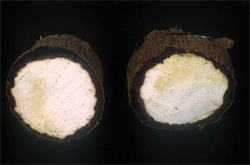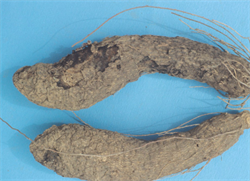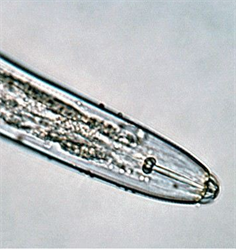- Widespread. NOT in Oceania.
- Major disease of cultivated and wild yams; alternative hosts: cowpea, melon, sesame. Similar to Pratylenchus (see Fact sheet no. 8). Impacts: yield, quality, planting stocks.
- On tubers: initially, creamy-yellowish shallow rots beneath skin, resulting in dark brown, dry, powdery, <2cm-deep rots, causing cracking and flaking. Rots continue in storage.
- Nematodes enter sets/tubers as roots/shoots emerge or through cracks in skin. Spear in mouth used for entry and feeding. Males and females live and breed (lays eggs) in tubers and soil.
- Spread: in surface and ground water, and in soil on footwear and machinery/vehicles. Long distance in tubers. Survival in stored tubers, and on roots of other crops and weeds.
- Biosecurity: risk from unofficial introductions, trade in yams, and possibility of different strains. Official movement of germplasm should always follow the FAO/IPBGR Technical Guidelines.
- Biocontrol: none.
- Cultural control: carefully inspect tubers when cutting sets – do not plant sets with rots; disinfect knives frequently with bleach; coat sets in ash; avoid planting where yams grown previous season; avoid planting after alternative hosts; provide optimum nutrients for rapid growth; weed; after harvest, collect and burn diseased tubers; ideally, plant after fallow or legume cover crop.
- Chemical control: hot-water treatment. Immerse yams before cutting in 51°C for 10 minutes (use a thermometer). Test method on a few tubers, producing nematode-free planting material for next season’s crop.
Pacific Pests, Pathogens and Weeds - Online edition
Pacific Pests, Pathogens, Weeds & Pesticides
Yam tuber dry rot nematode (529)
Yam dry rot. It is also known as yam nematode, yam dry rot nematode.
Scutellonema bradys.
AUTHOR Grahame Jackson
Information from CABI (2021) Scutellonema bradys (yam nematode). Crops protection Compendium. (https://www.cabi.org/cpc/datasheet/49315); and Bridge J, et al. (2005) Nematode parasites in tropical root and tuber crops (excluding potatoes). In: Luc M, Silora RA, Bridge J (eds) Plant parasitic nematodes in subtropical and tropical agriculture (second edition). CABI Publishing, Wallingford, UK, pp 221-258. (http://books.google.com.au/books?id=GAdsEt6dEtwC&pg=PA250&lpg=PA250&dq=scutellonema+bradys+yam&source=bl&ots=hM7P6PcHyY&sig=RoHp8WUtDqAEunoy9quvOSG_xfA&hl=en&sa=X&ei=e7bgU_nIMoPq8AX_jIKIBQ&ved=0CBsQ6AEwADgK#v=onepage&q=scutellonema%20bradys%20yam&f=false); Brunt AA, et al. (1989) FAO/IBPGR Technical Guidelines for the Safe Movement of Yam Germplasm. Food and Agriculture Organization of the United Nations, Rome/International Board for Plant Genetic Resources, Rome. (http://ecoport.org/Resources/Refs/IPGRI/yam.pdf); and from Yam nematode (Scutellonema bradys). Plantwise Technical Factsheet. (http://www.plantwise.org/knowledgebank/datasheet.aspx?dsid=49315). Photo 1 Dry rot of yam. IITA. (http://bit.ly/1FV6y4g). Photos 2&4 John Bridge Damage symptoms on yam tubers. CABI. (https://www.cabi.org/cpc/datasheet/49315). Photo 3 Yam tuber infected with dry rot. IITA. (http://bit.ly/1LKoMgW).
Produced with support from the Australian Centre for International Agricultural Research under project HORT/2016/185: Responding to emerging pest and disease threats to horticulture in the Pacific islands, implemented by the University of Queensland, in association with the Pacific Community.







